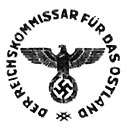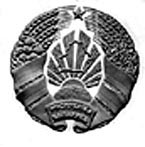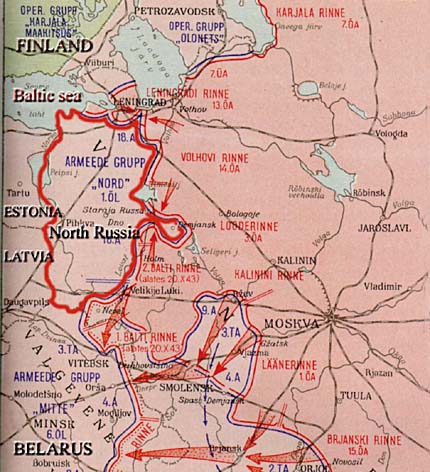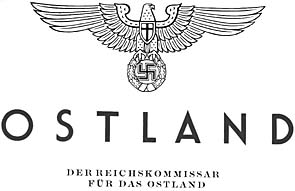|
|
||||||||
|
German Occupation of the Estonia, Latvia, Lithuania,
Belarus and North Russia
(Pskov & Leningrad regions) Special Issues of Paper Tokens & Coupons ( money
substitutes ) FIRST TRIAL CATALOGby
Ants Kulo & Juri Rudich
Eastern
region Fabric
Point tokens
ü
Ostland Spinnstoffwaren - Punktwertschein
ü Wi in Nord Chefgr. La Spinnstoffwaren - Punktwertschein COMMODITY
tokens
ü
PrÄmienschein
ü
Zuckerschein
ü
Kleineisenwaren-Gutschein
ü
Petroleum-Gutschein
ü
Nadelschnittholz wurde verkauft
ü
Eisen special
issues for
local using ü
Kreditchein der Zementfabrik «PORT-KUNDA»
ü
SonnenblumenÖl
Gutschein
ü
MaschinenÖl
Coupon
ü
IepirkŠanas
zimes
ü
Papyros Gutschein
TALLINN 1999
In this catalog the authors
list, describe and value about
90 different money substitutes, which were issued under German
authority in the territory of Estonia, Latvia, Lithuania,
Belarus & North Russia during World War II.
These money substitutes were used in addition to the general
legal circulated paper money - Reich’s Credit Treasury Notes
(Reichskreditkassen) with denominations: 50 Reichspfennig &
1, 2, 5, 20, 50 Reichsmark ND(1939-45). These are listed &
valued in SCWPM. Vol.2 and the authors don’t refer to these
Reich’s notes in this catalog.
The money substitutes described in this catalog were used
for receiving goods & provision rather than as circulating
money.
This is the first catalog using this theme and the authors
hope to receive remarks and supplements from all readers. Address for correspondence: Juri Rudich, P.O.Box 201, Tallinn EE10503, Estonia.
Tel./FAX: (372) 6342238. E-mail: rudich@infonet.ee
This catalog is printed in a limited edition of 100 copies.
Personal number and name register each copy.
All information of copies will be including in a special
author’s list.
Copyright Ants Kulo & Juri Rudich
ISBN
9985 - 60 - 625 - 6
All rights reserved. No part of this work covered by the
copyright may be reproduced or used in any form or by any means -
graphic, taping or information storage and retrieval system -
without the permission of the authors.
Contents
catalog #
page
I.Introductory information
1.Authors remarks.....................................................1
2.Map of region.......................................................2
3.Regional information................................................2
II.Eastern region fabric point tokens
- Reichskommissar für
das Ostland.....................................5 INTRODUCTORY
INFORMATION Authors’ remarks PRICES.
All prices are estimates in US$, based on the average retail
market of 1999. The marking «--» indicates that the item
exists or may exist, but a pricing is
impossible as no
information about the item being offered or traded is available.
It can’t be concluded that such material is of great value. BIBLIOGRAPHY. In
this work the authors used the following literature:
1.Catalog World War II
Remembered by C.Frederick Schwan &
Joseph E.Boling. BNR Press, 1995. USA.
2.Supplement for the collector’s catalogue. Issue
#10(January 1997)
- Çíàêè
ïóíêòîâîé öåííîñòè ïðÿäèëüíûõ èçäåëèé
Âîñòî÷íûõ îáëàñòåé
äëÿ ñäà÷è ëüíà è øåðñòè. Ëàòâèÿ./
Ostland spinnstoffwaren -
punktwertscheinen fur Flachs - und Wollablieferung. LETTLAND. by Igor Bukin. Riga, 1997. Latvia. (In this work the author analyzed more than 300 pcs of Latvian point tokens).
3.Supplement for the collector’s
catalogue. Issue #13(January 1998) - «Buying notes» of Trade department (Lettland, 1942) by Igor Bukin.
Riga, 1998. Latvia.
4.Supplement for the collector’s catalogue. Issue #14(05.1998)
- LETTLAND. The «Iron
notes». 1942 by Igor Bukin. Riga, 1998.
Latvia.
5.Catalogue World II War
Russian-German Occupations in Lithuania
by Aleksandras KUBILAS. LKA, VILNIUS, 1997/98. Lithuania. 6.Newspaper Òàãàíñêèé áîíèñò ¹1. July 1996. Article Ðàñ÷åòíûå êâèòàíöèè çà ñäàííîå ñûðüå ðåéñõñêîììèñàðèàòà Îñòëàíä. Ãåðìàíñêàÿ îêêóïàöèÿ âî
âðåìÿ âòîðîé ìèðîâîé âîéíû by Oleg
Paramonov.
Moscow,
1996. Russia.
7.Periodical Elva
Filatelist ¹3 /1996. Article PORT-KUNDAD,
mis
need on?
by H.Hiiemäe.
Eesti / Estonia.
The authors personally analyzed the following tokens used in
Estonia: fabric point tokens - more than 350 pcs, premium tokens
-
about 1.200 pcs, tokens for sugar - more than 1.000 pcs,
Port-Kunda
notes - about 500 pcs and many others substitutes for paper money.
The authors give special thanks to Alexandras
Kubilas(Lithuania)
for the used 6 images from his book, to Igor
Bukin(Latvia) for the
used 2 images & information from his three professional
articles in
the supplement for the collector’s catalogue, to Anatoli
Lagutin
(Estonia)for used his stock of premium tokens for analyze, to Lee Gordon(USA) for his 2 images of Byelarussian point tokens, great
thanks to Andrew
Clark(UK) for him help in correcting the
English text.
The authors hope for great interest this work and wait to receive
remarks, supplement, requests, etc. Map
of the region
The Republic of Estonia lies on the eastern shores of the Baltic
Sea.
Many wars have been fought in Estonia because of its strategic
location.
During the time of independence, before WW II, the territory of
the Republic of Estonia covered 47.549 sq. km - it is now 45.215 sq. km and has a
population of 1,4 million. The capital is Tallinn
(population in 1990 - 484.400).
In February 1918, the peace talks between Soviet Russia and
Germany
broke down. The Russians forces and the Bolsheviks fell back to
Russia in
the face of the advancing German Army. Representatives of the
larger
parties in the Land Council formed the Estonian Salvation
Committee, and
on February 24, 1918, the Republic of Estonia was declared in
Tallinn -
and it became the first of the small national republics in Europe
to be
formed by its oppressed peoples. According to
the Hitler - Stalin Pact’s
secret protocol(signed on August 23, 1939) Estonia became part of
the SU
sphere of influence and on June 17, 1940, the Red Army occupied
Estonia.
Thereafter there was, from 1941 to 1944, the Nazi German
occupation. From the autumn of 1944 the Soviets regained the rule of Estonia. On August 20, 1991,
the Parliament of the Estonian S.S.R voted to
reassert the republic’s independence.
The Republic of Latvia is the central Baltic state in East
Europe. The Republic of Latvia covers 64.600 sq. km and has a population of 2,6 million.
The capital is Riga with a population of 916.500
in 1990. Latvian political parties formed into the Latvian People’s Council which, on November 18, 1918, for the first time proclaimed the national independence of Latvia. On June 17, 1940, an unprovocated aggression was carried out against Latvia and Latvia was occupied by the Red Army troops. Within a few days of the Nazi attack on the USSR they entered Latvian territory and there followed the German occupation of 1941 - 1944. Latvia was retaken by the Soviets and reestablished as a member Soviet Socialist Republic of the USSR. Latvia declared
its independence from the
formed USSR on August 21,1991.
The Republic of Lithuania lies in the center of Europe (the
geometrical
center of the continent is in Eastern Lithuania, near the village
of
Bernotai, 25 km north of Vilnius), on the eastern coast of the
Baltic Sea.
The area of Lithuania is 65.200 sq. km and in 1990 Lithuania’s
population
was 3.723.000. The capital is Vilnius (592.500 inhabitants).
During WW I, Lithuania was occupied by the German Army in 1915.
On February 16, 1918, the Lithuanian Council issued a decree on
the
restoration of independence. The republic was occupied by Soviet
troops in
June 15, 1940 and annexed to the USSR. Following the German
occupation of
1941 - 1944 the Red Army forced the Germans out of Lithuania and
Soviet
order was reestablished in the territory occupied by it. By the act of March 11, 1990, the Supreme Soviet proclaimed the independence of Lithuania and it was recognized by the United States on September 2, 1991,
followed by the Soviet Government in Moscow on
September 6.
The Republic of Belarus (Byelorussia, Belorussia or White Russia
-
formerly Belorussian S.S.R.) is situated along the Western Dvina
and
Dnieper, bounded in the west by Poland, to the north by Latvia
and
Lithuania, to the east by Russia and the south by the Ukraine. It
has an
area of 207.600 sq. km. and a population of 4.8 million. Capital:
Minsk.
On February 25, 1918, Minsk was occupied by the Germans, and in
the
Brest - Litovsk peace treaty of March 3 between the Central
powers and
Soviet Russia the existence of Byelorussia was ignored.
Nevertheless, on
March 25, 1918 the National council proclaimed an independent
republic.
After the collapse of Germany the Soviet government repudiated
the Brest-
Litovsk treaty and on January 1, 1919, proclaimed a Belorussian
S.S.R. In
August 1919 Polish forces entered Minsk and occupied western
Byelorussia.
In 1922 the unoccupied occupied part of Byelorussia became a
founder
member of the USSR. In October 22, 1939, the Soviet army occupied
Poland
and part of western Byelorussia under a secret treaty signed on
August 23
between USSR and Germany.
In during WW II Byelorussia was occupied by German Army from 1941
to
1944. In 1944 the Red Army forced the Germans out of Byelorussia,
and
Soviet powers returned the republic to the USSR. In September
1991 the
Republic of Belarus declared independence. «North Russia»
North Russia was named by the German administration during WW II
and
included parts of the Pskov and Leningrad regions which were
occupied by
the Nazis from late 1941 to starting 1944. The Leningrad region
included territory up to the front line, which was placed about 20 km from Leningrad City, and to the coast of Ladoga lake. The Pskov region,occupied by the
Germans, was not included only northern territory
of this region.
Reichskommissar fÜr das
ostland & Wehrwirtschaftliche in Nord Chefgruppe
After the German army had swept through the Baltic countries and
invested
Leningrad, the economic development of the Baltic area was
important.
Among the products that Germany controlled were textiles, fibers,
metal
products, kerosene and provision of first needs(sugar, sunflower
oil,
cigarettes & etc.). All products were limited and unavailable
for free
public sale using circulated money. In order to maximize the
amount
removed to the homeland the quantities used by the local
inhabitants were
rationed. The tokens and coupons described and valued in this
catalog
were the vehicle for that rationing.
I. Eastern region
Fabric Point
tokens
Ostland Spinnstoffwaren - Punktwertschein
The title of these pieces translates as «Token point value of
spinning
products of Eastern regions for surrender of flax and wool», but
in
general they are known as “Eastern region fabric point token”.
The tokens
where authorized by a decree of Der
Reichskommissar fÜr das Ostland Henrih Lohse. General-Commissars in Reval (Tallinn), Riga, Wilna(Vilnius) and Minsk required to local Departments of Trade to issue exchange values, in points, from July 1942 for fabric and fabric products exchanged between suppliers and traders. These instructions valued 125 gr. of wool at 4 punkte and also established fabric point tokens in the values of 1, 3, 5 and 10 punkte. These tokens where to exchanged as a premium for the surrender of flax and wool. About fabric products, which sold for points, must be made mark in a consumer book of the surrender(on 8 or next page). These instructions were occasionally
modified after July 1942.
In addition to the full title given above the legend also states
that
“the holder of this card is entitled to purchase X points worth
of
spinning products” and “after redemption, cancel by cutting
in half”.
All tokens are bilingual, German and one of the five local
languages.
The front of the tokens for each region is the same except for
the name
in the upper left-hand corner; either Estland, or Lettland, or
Litauen, or
Weissruthenien(Weissruthenien / Belarus used the Russian language
on Punkt
token with expiration date 30.06.1943 and the Belarussian
language on a
Textil Punkt w/expiration date 31.12.1944). The vignette at the
left is of
a man carding flax whilst to the right is a woman shearing sheep.
The legend
around each vignette states “Flax and wool – blessing of the
land”.
The Nazi crest is at bottom centre and is marked of Der
Reichskommissar
fÜr
das Ostland(except Weissruthenien 1 Textil Punkt w/expiration
date
31.12.1944 which is marked Der
Generalkommissar in Minsk.
On the back both German and the local language is used to states
how many
points are required for each of eight items of clothing or fabric
and
explains that full schedules are available at shops. All tokens
have one
of four expiration dates given below the list of eight items. The
date is
either 30th June 1943 or 30th April 1944 or
31st December 1944 or 30th April 1945.
Also on the back of most tokens is the imprint Lettlands
Wertpapierdruckerei,
Riga (Latvian
printers of valuable papers, Riga),
hereafter referred to as LW,R.
This can be found with, and without, the printer’s control
number 6308, hereafter
referred to as LW,R #6308.
The imprint appears in Latvian, instead of German,
on some tokens; Rigas
litografija un ofset spiestuve atl 3173(Riga’s lithograph
and offset printer, license 3173, hereafter referred to as RLuOSa 3173).
The most common watermark is the word OST-OST repeating
throughout the paper,
but some tokens have a different watermark and some have none at
all. Some tokens are seen with their corner cut off, possibly as a means of a cancellation.
|








